Table of Contents
Book Review: Harmonic Mechanisms for Guitar – Volumes 1,2 & 3
When I first saw “Harmonic Mechanisms for Guitar” displayed at a music store back in 1980, I was fascinated by the material and was stunned that there were three volumes of it. Now, after 40+ years of working on the material —I feel like I’ve barely scratched the surface! Let’s see why I think George Van Eps’s Magnus Opus is still the epitome of guitar literature .
Background
When I first discovered these books, I had never heard George Van Eps play. I was familiar with the name, mainly from Guitar Player magazine (I have a near complete collection going back to 1967), but his vinyl albums at the time were out of print and very hard to come by. My only other points of references were “The George Van Eps Guitar Method” and “George Van Eps Guitar Solos”. So when I initially approached the material, I performed it in a manner that suited me, as compared to how Van Eps himself might have played it.
Eventually I came across a CD of Van Eps and Johnny Smith, and got to finally hear how he played. It wasn’t quite what I expected, but nonetheless, I could see how he used many of the devices from his books. I feel that having never heard Van Eps, while initially practicing the material, was a great aid, as it allowed me to filter it through my influences/interests, as compared to playing it in a more “traditional” jazz standards manner.
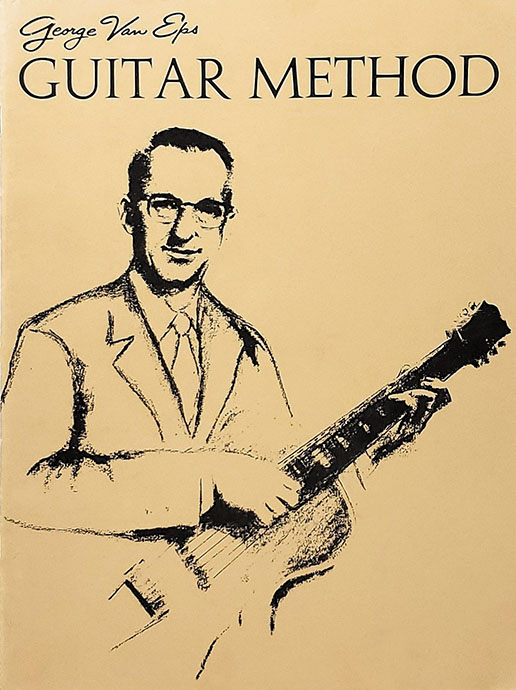
The George Van Eps Guitar Method
While it is not necessary to work through “The George Van Eps Guitar Method”, it is interesting to note that this is the initial appearance of Van Ep’s approach to triads, which is a huge component of “Harmonic Mechanisms”. The book starts out with Holding the Guitar, The Pick and Wrist Action, The Left Hand and The Attack and Exit. It also features a couple of photographs of a younger George Van Eps. (The book was originally published in 1939). It also features the first appearance of the Van Eps String Chart. (See below)
Essentially the guitar method takes major and minor scales and harmonizes them in triadic forms, while at the same time introducing various upper voice movements. He then moves onto the same type of material applied to 7th chords, including diminished chords. There’s enough material in the short 40 page book to keep a serious student busy for a while…
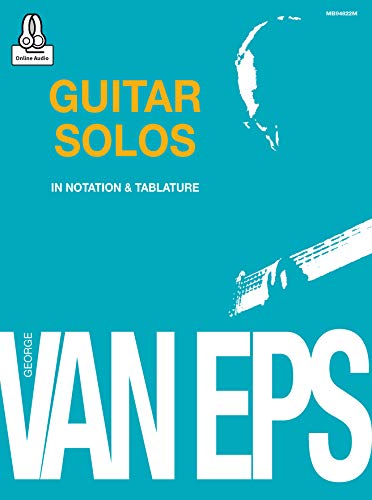
George Van Eps Guitar Solos
This collection of pieces shed further light on the inner workings of Van Eps and features numerous devices that are covered in Harmonic Mechanisms. Featured are nine original compositions and measures in at 48 pages.
I had originally worked through a copy of the original “George Van Eps Guitar Solos” and was always wondering how the songs “really” sounded, as there were no recordings of them, Years later, Mel Bay issued “George Van Eps Guitar Solos” with a CD of Charles Chapman performing the pieces. It was nice to hear someone else’s versions, which were, not surprisingly, slightly different than my interpretations. My favorite pieces to perform were “Love Theme No. 1” and “Waterfall”.
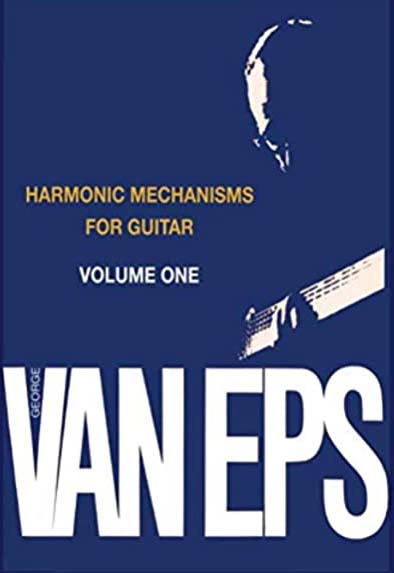
Volume One
Volume one features a blue cover and is 328 pages long. I have the original edition which features a spiral binding which aids in being able to open to a page without have the book close upon itself, or fold back the other half of the book to save room. There is a lot of material, and I am only going to address the sections that I feel are the most valuable. You might find other sections more pertinent to your approach of playing.
General Remarks
The book begins with a section entitled “General Remarks”. It is here that Van Eps starts to lay out his approach to the material presented in the book, including “The Mighty Triads”. There’s a lot of interesting insight provided, and it is the main section that is devoted to text, as compared to musical examples.
String Set Chart
Next up is the most confusing aspect of the three volumes, and that is the aforementioned Van Ep’s String Chart. Here he uses a series of letter/number combinations to illustrate the strings used in the examples. For instance, 1D/3 means 1st, 2nd and 5th strings, while 1/D3 means 1st, 3rd and 5th strings and 3/4 = 3rd, 4th, 5th and 6th strings. Some are more intuitive than others, but I can guarantee that you will be looking back on this page often!
Harmonized Scales
The initial series of examples are devoted to harmonized scales. The following scales are harmonized in triads: major, harmonic minor and melodic minor. Each section is devoted to a specific triad inversion, including root, first inversion and second inversion, and like the entire series of examples throughout all three volumes, each is featured in the order of the Cycle of Fifths. The triads include both open and closed voicings. These form the foundation of Van Ep’s triad approach throughout the volumes.
3 to 6 Up & 3 to 6 Down
This is the first series of examples that will be of interest to Contrapuntal players and it features the playing of a bass note and a third and having the upper line move from the third to the sixth in diatonic fashion, while keeping the initial bass note held. This is an excellent place to start, in case you want to skip around the book to various sections of interest. And yes, the fingerings are for major, harmonic minor and melodic minor and moves through the cycle of fifths. The next section features the opposite, starting with a sixth interval and then moving the bass line down to a third, again with all of the previous variations.
6ths With Upper Line Motion
In this section there are examples of bass note and sixth being held, while the triadic arpeggio of the chord is played above it and ending on the sixth.
10ths to 3rds & 3rds to 10ths
These are similar to the previous series with sixths, but this time using tenths. The main challenge here is to keep the bass note sustaining while playing the series of notes in the upper line.
Chromatic Scales with Various Intervals
This is a section that has proven to be quite useful in my teaching curriculum over the years, as it prepares the students fingers to a wide variety of intervals and the ability to play them chromatically across the guitar neck. All of the standard intervals are included, starting with Major 2nds and finishing with 15ths. Excellent for developing finger dexterity and coordination.
Super and Sub Triads
For players looking to expand their triadic playing, there is a large section of the book devoted to Super and Sub Triads. A triad that has one of its voices moved diatonically upward is considered Super, and when one of the voices move downward diatonically, it is considered Sub. This is an excellent section of the book and there is a great amount of work here, however, the concept is simple enough that you can easily incorporate it into your playing without having to study all of the pages devoted to it.
This is generally how I think of chords, with one voice (or more) moving and the other notes supporting, just like a piano. Which is why Van Eps called his style of playing “Lap Piano”.
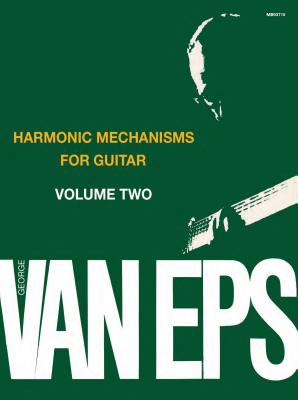
Volume Two
Volume two features a green cover and is 381 pages long and includes a few pages of manuscript pages at the end of the book. Again, there is a lot of material, and I am only going to address the sections that I feel are the most valuable, especially for Contrapuntal playing. This is probably my favorite volume, as there is a lot of great material contained within.
Reductions
Almost half the book is devoted to Reductions. These include 6 to 1, 1 to 6, 8 to 1, 1 to 8, 3 to 10 and 10 to 3. These use the same concepts introduced in the previous volume. Excellent practice for sustaining one note and moving a series of other notes. Players often have an issue with slightly releasing the pressure of the finger holding down the sustaining note and “killing it” before the end of the phrase. These reductions train the left hand on the amount of pressure needed to sustain the note, while at the same time preventing the “lifting” or pressing too hard while moving various lines.
Contrary Motion 6 to 8 to 10 to 12
This was the section that really caught my attention when initially looking through these books. Starting with the sixth interval the bottom line moves diatonically step wise down, while the top line ascends diatonically, this results in the intervals 6th, Oct, 10th and 12th. Shown in all 12 keys. It’s only a couple of pages, but they were a “life changing” couple of pages!
10th Reductions
This is another example of a couple of pages in the middle of nowhere that has revelatory information. It is also one of the rare occurrences where the information isn’t presented in all 12 keys. When played across the page the reductions (measure by measure) to from; 10 to 8, 9 to 7, 8 to 6, 7 to 5, 6 to 4, 5 to 3, 4 to 2 and 3 to 1. The next line repeats the process, but starting on the next diatonic note of the scale. What is fascinating about it is when you start mixing things up and reading DOWN the page in each of the reductions, and seeing the relationships between the movable forms.
10ths With Inner Line Motion
Many solo guitarists tend to use a lot of 10ths in their playing to get a nice sounding separation of lines. With this section of the book, Van Eps expands upon this concept by playing tenths diatonically with inner line movement. Since three notes are played together initially, these could actually be thought of as “triads” with a moving inner line.
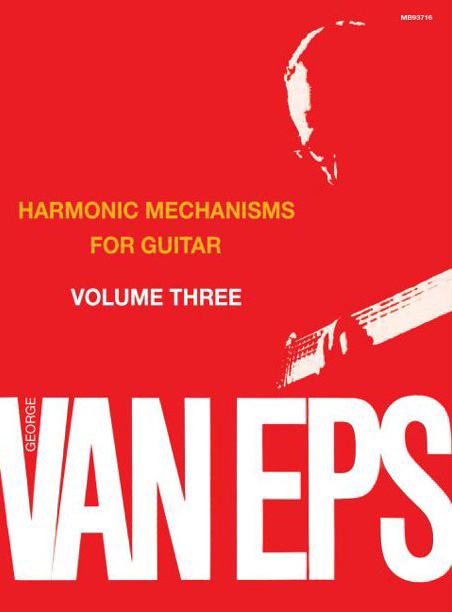
Volume Three
Volume three features a red cover and is 188 pages long. Although this is the smallest book, there is still valuable content contained within.
Articulated 10ths
This section can be thought of as playing 10ths as scales, using the first and third fingers to play the first tenth and then the second and fourth fingers to play the next one. Scales are in all twelve keys and each of them are an octave in length. There are also examples with the 10ths being played as harmonized arpeggios.
Articulated 6ths
This is the same concept as the previous section, though this time the fingerings are more varied.
Conceptual Material
The other sections of the book contain conceptual material that may be of use to more chordal oriented players. These include, The Stagger Concept, The Satellite Concept and The Displaced Concept. There is also a section on playing Odd Against Even lines. Although this is the “weakest” book of the series, it does contain a lot of good information, though you should only consider this volume if you have worked through the other two books and you want to expand your knowledge further. If you are a Contrapuntal player, you could probably pass on this volume and not really “miss” anything.
https://www.melbay.com/Products/94822M/george-van-eps-guitar-solos.aspx
https://www.melbay.com/Products/93667/george-van-eps-harmonic-mechanisms-for-guitar-volume-1.aspx
https://www.melbay.com/Products/93715/george-van-eps-harmonic-mechanisms-for-guitar-volume-2.aspx
https://www.melbay.com/Products/93716/george-van-eps-harmonic-mechanisms-for-guitar-volume-3.aspx
Summary
Although I have studied over 100+ guitar books over the years, this series is still what I consider to be the best books available for studying this type of material and overall the best series of books in guitar literature. Make no mistake, this a lifetime’s worth of content to study and you will NEVER be able to study/memorize everything between its covers. In all likelihood you will find several sections of primary interest and focus on them, and that could take you years to work into your playing. Van Eps was a genius and it’s no surprise that these books reflect that.
Back in the 1980’s I started to use the first volume of the series as one of the books that I had serious students study. Even though many of them initially balked at the material, it soon became clear that the facility that they were becoming accomplished at, made it easier for them to play what they were interested in (Satriani, Malmsteen, etc.), and that is one of the surprising aspects of the books – although you are playing two or more notes at a time, it really develops your dexterity for single note playing.
It is mind boggling to consider the amount of time and effort that went into producing these volumes of books. Being as meticulous as he was, it is no surprise that Van Eps produced the definitive book on guitar harmony. All of the material is extremely useful, though you will have to choose what appeals most to you, as there is just so much information.
Who should study these books? I would break it down into two types of players: Standards/Chord Melody and Contrapuntal players. While there is clearly overlap between the two, there is sufficient amount of material to satisfy either player’s approach and thus neither one will feel “neglected” by their stylistic choice.
And while the material seems to be “advanced”, it can easily be absorbed by an eager beginner who has aspirations for either of the aforementioned styles. Though, intermediate and advanced players will clearly get the most out of it, due to their experience level and techniques developed. These are NOT books for pick players, the use of your right hand fingers is absolutely necessary.
This is another series of books that I am looking forward to adapting to my recently acquired 7 string Hybrid Guitar, as the thought of have the bass notes as actual bass notes is something that I’ve been longing for for 40+ years, and I’m finally able to hear the sounds that I was envisioning all these years. Nevertheless, the material sounds great on my Ramirez classical guitar, Guild archtop and Les Paul. The concepts also sound great with midi synths triggered by a Fishman Triple Play midi converter mounted on my Les Paul.
These are “must have” books for those interested in Contrapuntal playing. Working through this material will certainly yield impressive results – if you are willing to put in the amount of work necessary. Of course, then it is up to you to take the concepts and apply them to your own compositions and improvisations!
My use of these techniques is filtered through my influences: Allan Holdsworth, Pat Metheny and Keith Jarrett. So while it is obvious that these techniques are useful for Solo Jazz guitar (Standards), they can also be used for more contemporary approaches, and styles, and sound just as good in those contexts.
Needless to say, Very Highly Recommended!
Final Words
I’d like to take a moment to thank everyone who has purchased my book! I appreciate your interest and support, and if you have any questions, feel free to reach out and contact me!
As mentioned in my last post, I’ve been splitting my time between 3-4 hours of guitar practice and 3-4 hours of drawing practice. For fun, I’ve again enclosed a recent master study drawing that I did of Frank Frazetta’s “The Norseman” painting, using Procreate on an iPad Pro, using an Apple Pencil 2.

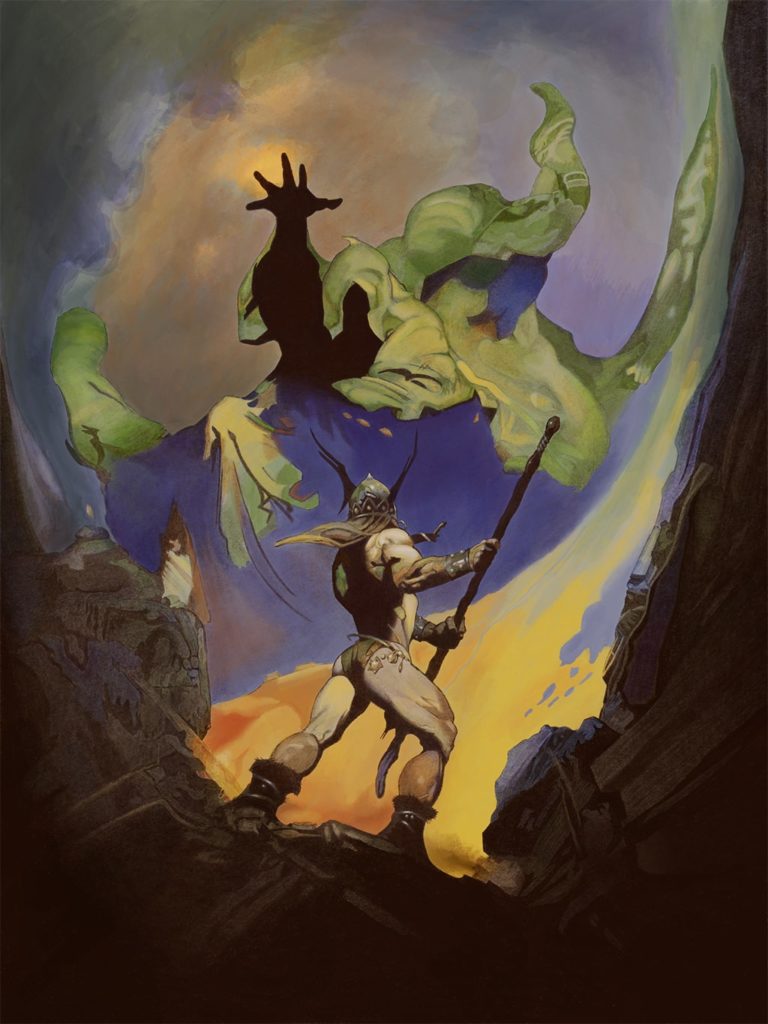

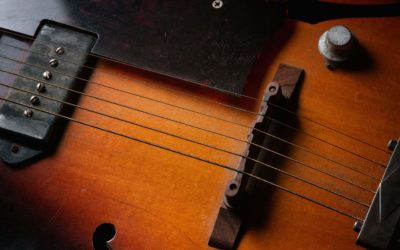
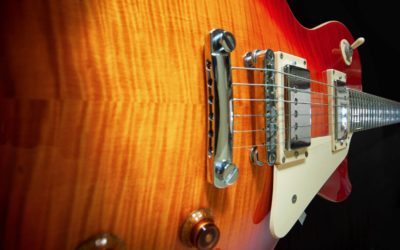

0 Comments